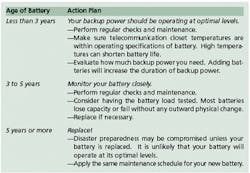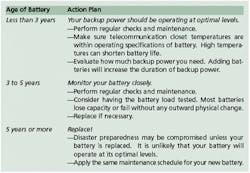Disaster preparedness for an ISDN voice network
Unexpected events involving voice and data networks can include but are not limited to natural disasters, fire, prolonged power outages, technology failures and terrorist acts. Many networks received major overhauls during the Y2K initiative. But most of those were based on the prospect of system failures as a result of software crashes.
Y2K often ignored life expectancies of fundamental subsystem hardware, such as backup power. With more than 300,000 Integrated Services Digital Network (ISDN) Primary Rate Interface (PRI) ports deployed between 1996 and 2000, ISDN voice networks have reached the stage where subsystem failure can be costly—both to users and service providers. Some subsystems should be monitored or replaced so that disaster preparedness is not compromised.
Power for ISDN telephone systems is provided by a power supply and battery combination located in the premises telephone closet. The power supply converts 120-V AC to 48-V DC that provides power to the phones, network interface adapters, (NT1s), and charges the batteries. When local AC power is interrupted, the batteries automatically provide continuous power to the phones and NT1s.
The Lucent 1145* power supply and battery combination is one of the most common power systems deployed in ISDN voice networks, with other popular systems including those from System Engineering International (SEI). Both Lucent's and SEI's products use sealed lead acid batteries, whose life expectancy is approximately five years in a normal telephone closet environment. Battery life, however, is highly variable. High operating temperatures, high number of discharge cycles, and long periods of being in a discharged state can all significantly reduce battery life.
As batteries age, they lose capacity and can no longer provide sufficient backup power for the length of time required. Depending on age and use history, the capacity loss can be total (i.e., the phone system will not operate at all if AC power is lost). ISDN phone systems should be able to operate on battery backup power for a minimum of two hours, with four hours considered normal and eight hours needed for mission-critical operations.
So, if the batteries in your ISDN system are more than five years old, it is likely that the system will fail or not operate for the expected period of time should AC power be interrupted. To ensure uninterrupted phone service, now is the time to replace your battery.
Action plans to consider for disaster preparedness are listed in the chart (above).
Downtime can cost your company millions of dollars a year. A disaster preparedness plan for your ISDN voice network can mitigate the impact of the unexpected.
Johnny Parham is the founder of TechRep Associates, LLC, New York City, a value-added distributor of cabling and communications equipment. Contact him at johnny.parham@ techrepllc.com. William Kautter is director of engineering for System Engineering International (SEI), a supplier of power systems for ISDN-based customer premises equipment. Contact him at [email protected].
* Lucent no longer makes the 1145. A direct replacement for both the 1145 battery and rectifier is manufactured by SEI. The S1145 battery and power supply mount on the same back plates as the Lucent models and use the same electrical connections. The S1145 battery includes an Automatic Battery Test that provides an indication when the battery needs to be replaced.

